by tmoffett | Sep 13, 2010 | Color, Composition, Landscape
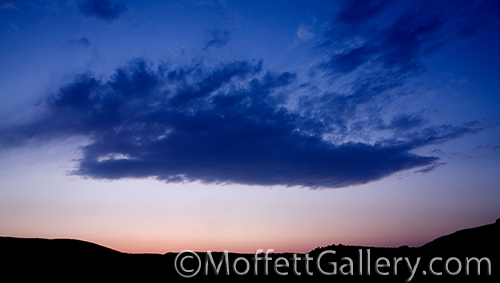
Sunset in the Owyhees
The last light of the evening is always my favorite. The light gets real moody and creates an almost surreal feeling in the images. The contrast is low, so detail is maintained in both shadows and highlights unlike anything that can be created during an earlier time of day. Colors also become saturated. I love how with careful attention to exposure I am left with little work to be done in Photoshop. The in camera image is nearly perfect.
Next to lighting and exposure, composition decisions are critical. Note how the cloud in this image mimics the shape of the mountain tops along the horizon. Cropping is done in camera to make sure that the horizon line does not split the composition in half. I really like moving the horizon down near the bottom, allowing for more sky and the drama of the sunset to become dominant. In this photograph, the warm color in the middle, sandwiched by the cool blues on top and bottom are what make the color scheme work. Dark tones, rich in detail fill the shadows and holding my attention as I search them for answers. Answers to what, I am not sure, but I keep looking none the less. It’s all a mystery.
by tmoffett | Sep 12, 2010 | Color, Composition, Landscape
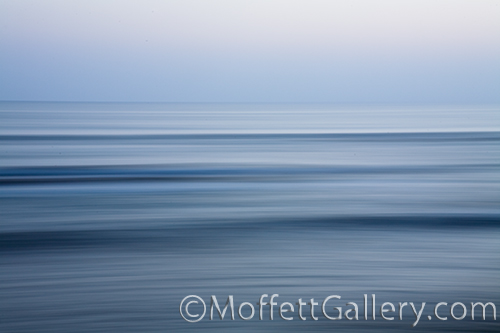
Horizon in Blue
This is one of the first successful images I made using the techniques I have been using for my Horizons series. The abstractness of the water created by the motion of the waves coming ashore while keeping the horizon line sharp creates an interesting feeling and mood that changes according to the color scheme of the image. The series started as an abstract study of color and has developed into a full portfolio that stands on its own. The mood created by the motion and color combination is unlike anything I have I have done in the past.
Horizons, the portfolio, began as an abstract study of color and motion on the sea while on an anniversary trip in Kauai. As I captured the motion of the waves as they came ashore, I became very interested in the feeling that a still image of moving matter created. The reflected colors from the sky in the water added to the emotion of each image as well. With all of the motion going on, the real challenge for me in this series of images is to maintain a crisp horizon line. By maintaining a sharp horizon, a reference point is made that helps to keep each image real, kind of dreamlike, but still grounded in reality. It is a feeling that I have not been able to recreate any other way.
by tmoffett | Sep 11, 2010 | Color, Landscape, Photographic Philosophy
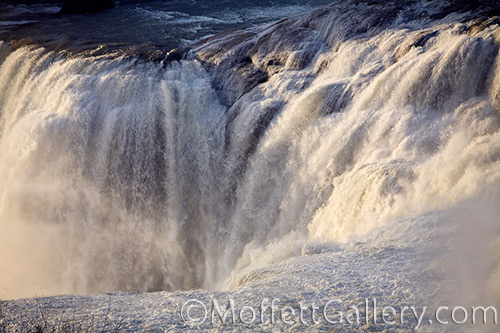
Vortex, Shoshone Falls
Normally I like to blur my photos of running water, but on this occasion I changed my mind. The water flow was so high that blurring the motion of the water going over the falls caused the whole image to look mushy. With streams and waterfalls I prefer a lower flow rate as that will create a nice ribbon effect with the bands of water. When slowing the shutter down with this much flow, the ribbons of detail disappear and everything becomes white. With this in mind, I decided to speed up the shutter and freeze the motion of the water as it went over the edge. I thought it was an interesting perspective, one that I have not seen before.
by tmoffett | Sep 10, 2010 | Black and White, Landscape, Photo tips
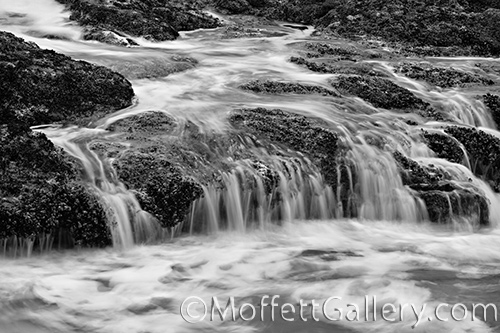
Shoreline, Yachats, Oregon
The evening we arrived in Yachats we were met with rain, however that did not stop me from photographing. We climbed out on the rocky shelf overlooking the sea and watched the waves come in. It was quite a spectacle. The waves would crash into the rock and spray seawater everywhere. The water would rush up on the shelf and then slowly retreat to the ocean just in time to meet the next wave. I photographed the waves for a while and then turned my camera inland and watched and photographed the retreating water. It appeared as a river flowing downstream and over small falls. As I photographed, Christeena was holding an umbrella, not knowing which way to hold it. Should she keep the rain off of me and the equipment of protect me from the ocean spray? It didn’t matter. Either way I got wet!
I often have students say they couldn’t photograph because of inclement weather. I only need to show them a few images and they realize that they are only making excuses. Some of my best photographs have been made during stormy weather. Students quickly learn that I won’t accept excuses of this kind, as I know, and they soon learn, that great opportunities are missed by not photographing during a storm. They just need to find a way to keep their gear dry and protected. This can be accomplished quite easily with an umbrella or even a garbage bag. When that is accomplished, a whole new world of creativity and opportunity are opened up. I love a good storm.
by tmoffett | Sep 9, 2010 | Color, Composition, Landscape
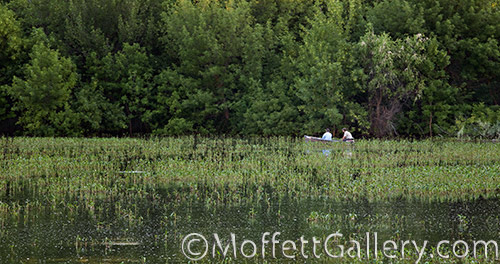
In Search of Bass
Yesterday I posted a little bit about black and white. While I do love black and white, I have been into color a lot more the past couple of years. Much of my color work, however is monochromatic in nature. I just can’t get away from that look. One color, great tones, it just works.
What I like about this image is the fishermen. Everything is green except them. That draws the attention to them and breaks up the color just enough to make it work. Without them, this image just does not work at all. Along with the monochromatic color, repetition is at play here. Again, it is the two fishermen that break up the repetition enough to make it interesting. I was fortunate to be at the right place at the right time to capture the image.
by tmoffett | Sep 8, 2010 | Black and White, Composition, Landscape, Photo tips
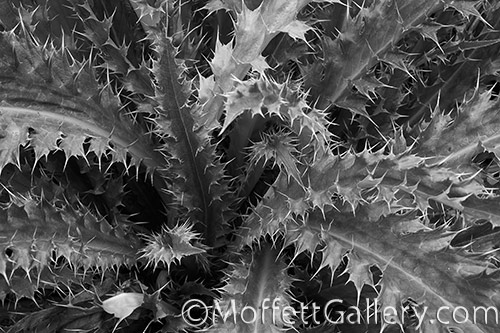
Untitled
When working in black and white, there are many factors to consider while making the photograph. Tonal range, local contrast and composition to name a few. Usually the overall tonal range should go from a deep black to bright white while maintaining good detail throughout. If the exposure is off at all, loss of detail on one end of the scale or the other becomes a problem. Light quality is ever important in creating images with a great tonal range. Once the overall tonal range is established, local contrast, the contrast between to adjacent objects in the image, must be controlled. In the darkroom, I control this by using different grades of paper. With digital, I use curves adjustment layers with layer masking. When everything is just right you will end up with a print with rich tones and great detail.
Composition is another whole ball game. In the above image, line, repetition, texture and rule of thirds are all important. They work together to lead the viewers eye from the outside down inside the plant. While traveling down the plant, every prickly point is rendered in rich detail. I begin to feel the image. I know I do not want to touch it. It is sharp and prickly. the eye is led to the lower left quadrant, off center just enough to create interest.
I love black and white. Quality black and white photography is becoming a lost art. Digital cameras have made it too easy that we forget at times to slow down and think before pressing the shutter. Shooting by instinct is great, but first learn technique so that when shooting by instinct or feeling you get the tones and composition right. It will improve your photography, I promise!








Recent Comments